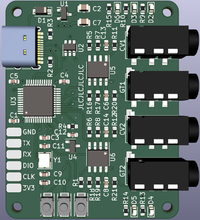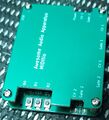MIDItio
MIDItio is a planned USB Midi to CV device. The device will act as a USB MIDI device connected to a USB host. It will be able to run two channels simultaneously with a CV indicating the pitch and a Gate indicating start and stop.
The name MIDItio is derived from MIDI and the Latin "ditio" which means "control".
Planned features are:
- USB MIDI Gadget/Device
- 2 MIDI channels
- Dual pitch CV output (1V/oct)
- Dual gate output
Hardware Design
MCU
The primary concerns dictating the choice of MCU are:
- Built-in USB
- Built-in Digital to Analogue converters (DAC) - preferably 2
- Cost
The STM32L151 fits the bill nicely.
Output Amplifier
Without a boost regulator the highest available voltage on the board is the USB VBUS 5V. That means the output amplifier for the CV's need to map 0-3.3V into 0-5V.
A = 5 / 3.3. = 1.515
The amplification of a non-inverting opamp is:
A = 1 + Rf / R2
If we choose R2 = 9.1 kΩ, we can calculate Rf
Rf = (A - 1) * R2 = 0.515 * 9.1 kΩ = 4.68 kΩ
A Rf of 4.7 kΩ should do nicely.
Self calibration
The output amplifier will add a certain DC error (due to tolerances on the resistors) and we'll need a way to calibrate the device. In our case we simply feed the amplified output back to an ADC. The input pins on STM32 are 5V tolerant when in digital mode, but when set to analogue they are not! So some care should be taken not to set the value higher than 3.3 V while calibrating.
The internal voltage reference in the STM32 is quite poor, so we have also added a 0.1 % voltage reference. That way we can compare the measured values of the DAC's with this voltage reference and adjust for any errors.
Schematics
Renderings
Prototype rev a
First prototype was ordered and this is how they turned out:







